Kashi (Varanasi) (Vishwanath Temple) information, story, history, importance, facts, significance | Jyotirlinga
Namaste friends, how are you doing today? Welcome to #BhagavanBhakthi website / blog.
Bhagavan Lord Sri Vishnu, Bindu Madhav, Krishna, Rama, Goddess Sri Lakshmi, Goddess Rukmini, Goddess Sita, Lord Shiva and Goddess Parvati (Annapurneshwari) blessings to you and your family!
In this website / blog, you will always learn about #Hinduism #Sanskrit language.
Also subscribe to my YouTube channel from this link #BhagavanBhakthi to view videos about #Hinduism #Sanskrit language.
Just before going to “Kashi (Varanasi) (Vishwanath Temple) information, story, history, importance, facts, significance | Jyotirlinga“, let us know a brief, basic and very important information.
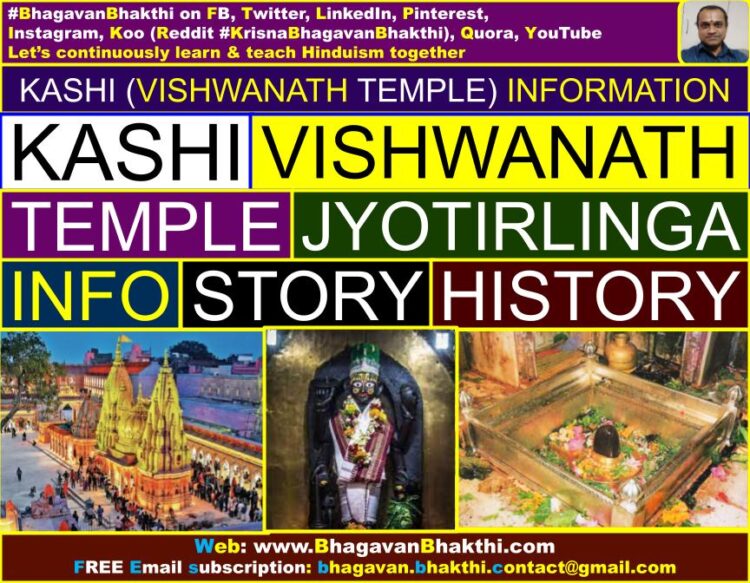
First of all let us all know the meaning of the words Kashi, Varanasi and Banaras. Kashi – Kashi means something bright, highly shining, illuminating, splendid, etc. In Sanskrit ‘kaash’ means to shine brightly.
Thus total meaning of the word Kashi = Kaash (काश) + i (ई) = shining brightly + this place. Means, this is a place which shines very brightly always.
Varanasi – ‘Varuna river with the Ganga river being to its north’ and ‘that of Asi (Assi) river and the Ganga river to its south’, that means a place where Varuna river along with Ganga river is situated to the north. Similarly, Assi river along with Ganga river is situated to the south.
Varanasi = Varana + asi = Varuna river + asi (assi) river, that is, this is a place where Varuna + Assi rivers flows along with Ganga river.
Banaras – Banaras is a miss pronounced word of the Varanasi. Here ‘Va’ has become ‘Ba’. Many must be aware in few words like Vinod, Vijay, etc. are pronounced as Binod, Bijay etc. Kashi or Varanasi or Banaras is one of the oldest and continuously inhabited city in the world. Kashi or Varanasi is one of the holiest city for Hindus and Sanatana Dharma.

Kashi or Varanasi being one of the most sacred teertha kshetra / pilgrimage places for Hindus of all denominations, that is, whether it may be for Brahmins, Kshatriyas, Vaishyas or Shudras, this is one of the highly privileged places for all the varna people of the Hinduism.
Kashi or Varanasi has the highly holy idol (deity) of Lord Kashi Viswanath (one of the manifestations of Lord Shiva) and also one of his twelve most revered Jyothirlingas of Lord Shiva.
The Dwadasha Jyotirlinga (twelve Jyotirlinga) names are as given below:
Ramanathaswamy in Rameswaram, Tamil Nadu | Bhimashankar in Maharashtra | Mallikarjuna in Srisailam, Andhra Pradesh | Mahakaleswar in Ujjain, Madhya Pradesh | Somnath in Gir Somnath, Gujarat | Omkareshwar in Khandwa, Madhya Pradesh |
Kedarnath in Rudraprayag, Uttarakhand | Vishwanath in Varanasi, Uttar Pradesh | Grishneshwar in Aurangabad, Maharashtra | Trimbakeshwar in Nashik, Maharashtra | Baidyanath in Deoghar, Jharkhand | Nageshwara in Dwarka, Gujarat |
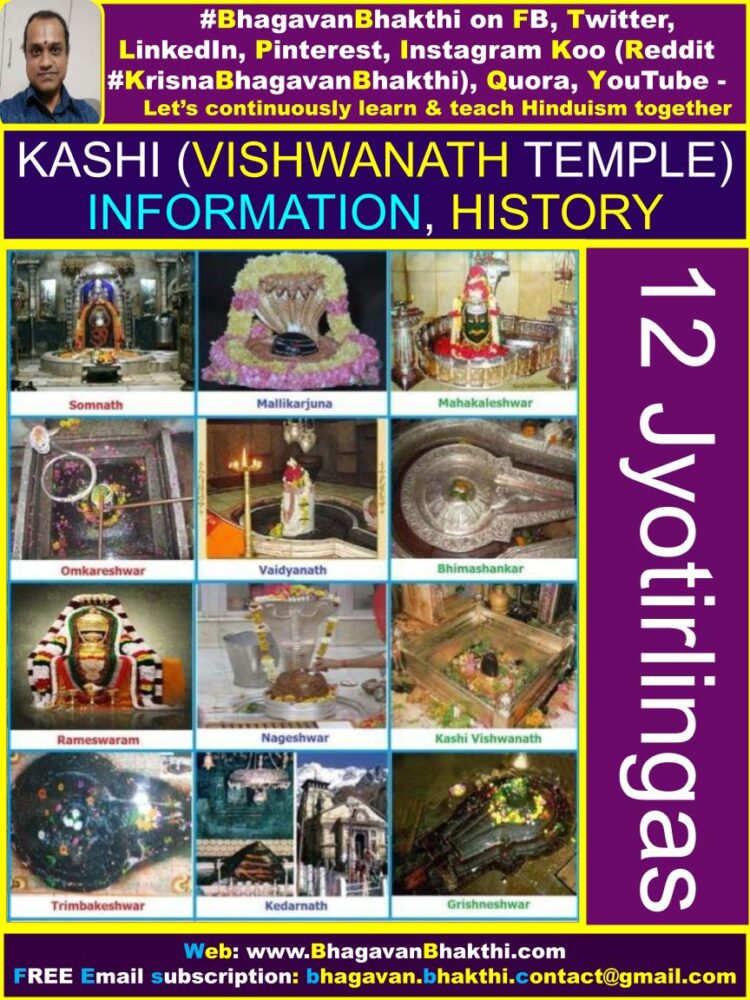
Kashi or Varanasi or Banaras is a city situated on the left (west) bank of the river Ganga in the present state of India called Uttar Pradesh. As explained above, Varanasi is the Sanskrit name and Banaras is the common name of the people.
In earlier times, Varanasi was known by various names as given below:
Aanandakaanana | Avimukthaka | Brahma Vardha | Kashi | Mahaasmasana | Ramya | Sudarshana | Surandhana |
Kashi or Varanasi is definitely the oldest surviving city of the world and the off course the richest cultural capital of India. Kashi or Varanasi is standing on the western banks of India’s holiest river Ganga.
Kashi or Varanasi is in the right middle of the city, that is, Kashi or Varanasi stands at its fullest majesty with the Kashi Viswanath temple (Devalayam / Mandir). In this temple (Devalayam / Mandir) itself, the Jyotirlinga of Lord Shiva is situated.
Kashi or Varanasi has always attracted and charmed a huge number of bhaktas / devotees, pilgrims and worshippers from time immemorial. It is said in our shastras (Hindu Texts) that, a simple glimpse at the Jyotirlinga is enough to cleanse our paapas / sins.
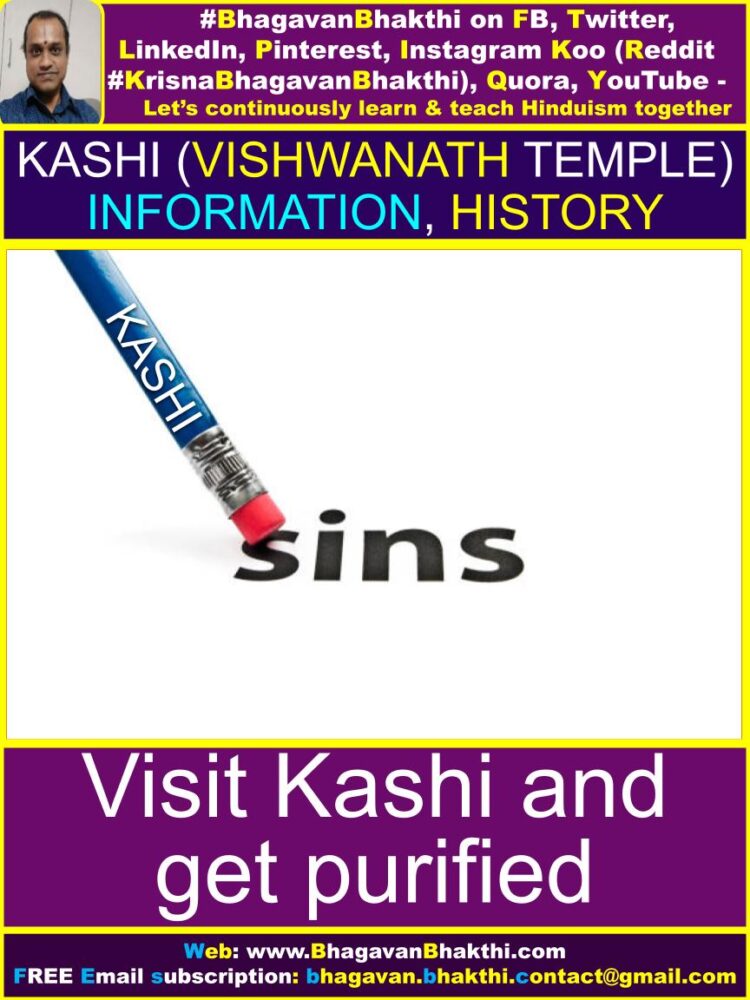
Kashi or Varanasi Jyotirlinga has a highly special and superbly unique significance.
It is said in our shastras (Hindu Texts) that, the merits earned by darshanam of other Jyotirlingas (other 11 Jyotirlingas) spread in different parts of India accrue to a devotees the same punya (good deeds) by just a single visit to Kashi Vishwanath temple.
As said above, the word ‘Kashi’ originated from the word ‘kaash’ which means to shine very brightly, that is, to glitter or to sparkle, or to illuminate.
With rich in the legacy, Kashi or Varanasi is the original place created by svayam Lord Shiva and Goddess Parvati Devi and thus they both are positioned at this very place since the time immemorial.
Kashi or Varanasi is one of the “Sapta Pavitra Nagaram / Sapta Puri”, that is, seven sacred cities in Hindu Sanatana Dharma [(Ayodhya, Mathura, Maya (Haridwar), Kashi (Varanasi), Kanchi (Kanchipuram), Avantika (Ujjain) and Dvaravati (Dwarka)].
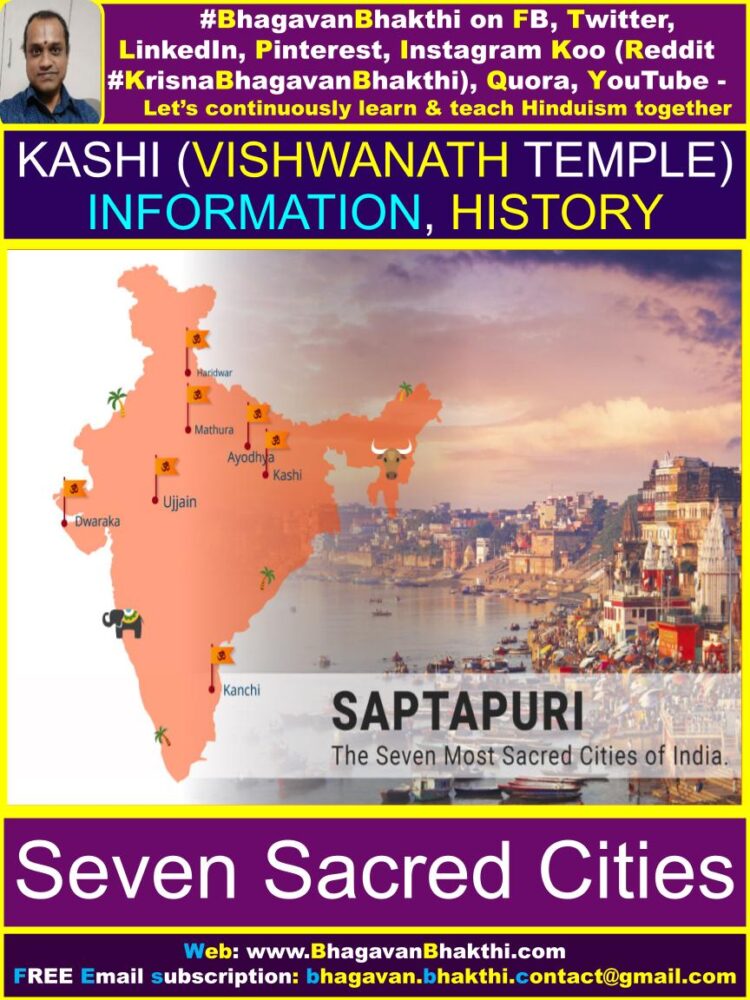
Kashi or Varanasi city is mentioned in various Hindu Shastras / scriptures. This includes the following:
Mahabharata | Ramayana | Rig-Veda | Skanda Purana | Vamana Purana | And others |
As per Vamana Purana, both Varuna river and Assi river originated from the body of aadi purusha / primordial person at the beginning of time. As said above, the tract of area lying between these two rivers is the place called ‘Varanasi’, and this is one of the holiest of all pilgrimage places in India.
Place Kashi as given in Puranas : In Skanda Purana (it is one of the 18 principal Hindu Puranas) in its most celebrated chapter called Kashi Khanda, it is said that the glory of Kashi Temple (Devalaya / Mandir) and its Lord Viswanath was narrated by Skanda himself (Lord Kartikeya, son of Lord Shiva and Parvati Devi).
(Note : Lord Skanda is also called as Lord Kartikeya and he is the warrior son of Lord Shiva and Goddess Parvati Devi. Skanda’s brother name is called as Lord Ganesha.)
According to the Skanda Purana, Lord Skanda or Lord Kartikeya said that “Kashi cannot be attained by mere performing tapas / austerities and it can be attained only when one has the blessings of Lord Shiva”.

“A person who is fortunate enough to have reached the place Kashi, must not leave it till he is alive on this earth.”
Lord Skanda or Lord Kartikeya also adds, “There is no holy place as dear to Lord Shiva as Kashi which is not abandoned by him and as well as his consort Goddess Parvati Devi, even at the time of pralaya / deluge”.
“Lord Shiva named this holy place as Anandavana, because it gave him immense joy (Ananda).” (Here Aanandavana = Aananda + vana = Immense joy + garden / place.)
Rishi Agastya and Lopamudra story : As said in Skanda Purana, once the great Rishi Agastya went on to clarify his wife Lopamudra, that there are many holy places capable of giving moksha / salvation. But none of them can match Kashi, because Kashi cannot be compared with any other places on earth.
Kashi was a holy place even during epic times like Ramayana, Mahabharata, Vaidik period, etc.
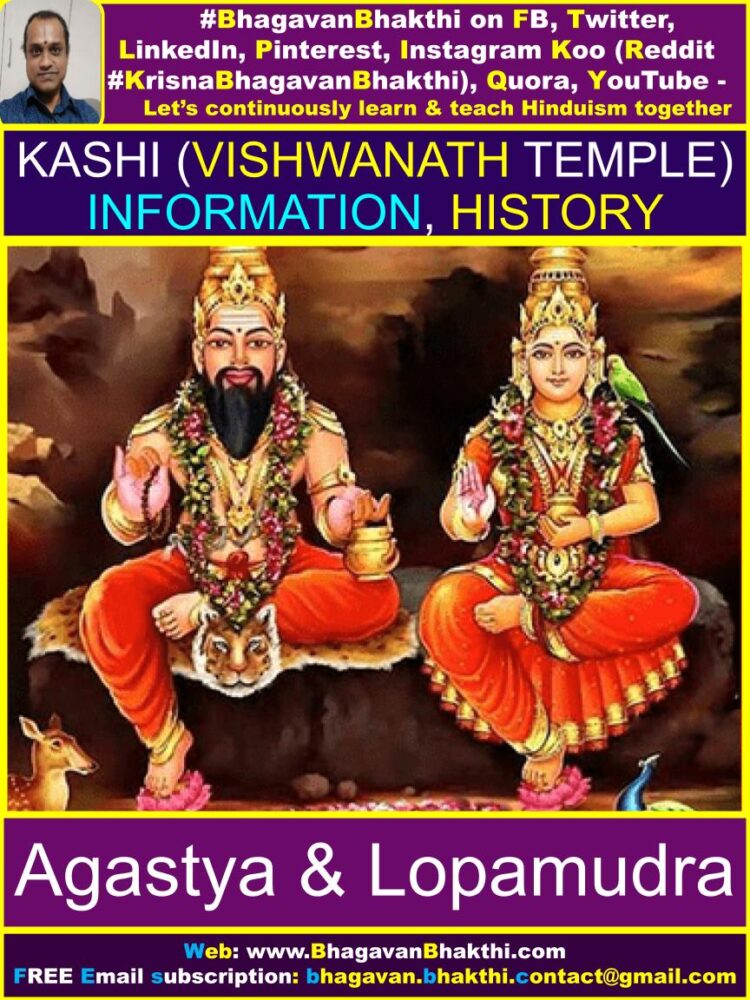
Lord Shiva was worshiped here with great bhakti / devotion in epics like Ramayana and Mahabharata:
The third consort of Dasharatha maharaja, that is, Sumitra Devi was from the same place Kashi. In Ramayana, both Lakshmana and Satrughna were the sons of Sumitra and Dasharatha.
Here in the same place Kashi, both the Satrughna and Lakshmana had lived for few years along with their mother Sumitra.
Similarly, in Mahabharatha Kuru king Vichitravirya’s wives Ambika and Ambalika were from Kashi. Both of these ladies who were abducted by the Kuru great Bhishma along with their elder sister Amba. Dhritarashtra was the son of Ambika and Pandu was son of Ambalika.
To know more information about the “Amba, Ambika, Ambalika information, Bhishma story, husband, sons, kingdom”, please visit this link: Amba, Ambika, Ambalika information, Bhishma story, husband, sons, kingdom
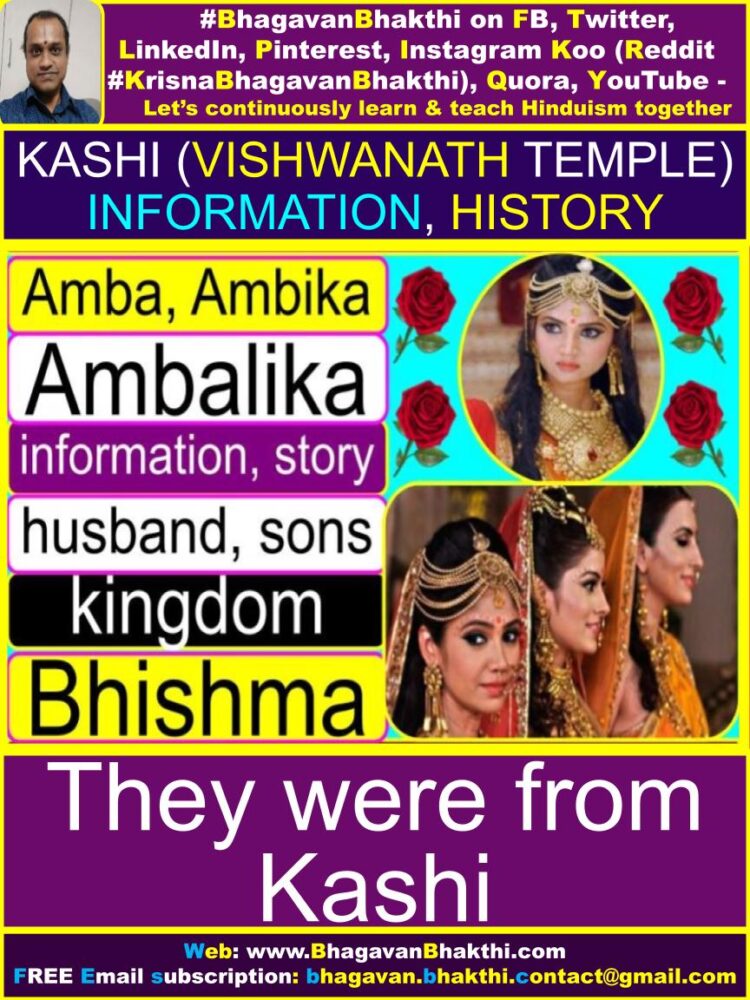
Kashi in Satya Yuga : During the Sayta Yuga, great Satya Harishchandra period, he himself along with his consort Taramati Devi and son Lohita (also called as Rohita) had lived in the same place of Kashi during their hard times.
To read the full story of “Satya Harishchandra, Vishwamitra full story”, you can visit this link: Satya Harishchandra, Vishwamitra full story
Now let us all know the origin of the place Kashi : Once Lord Shiva told Goddess Parvati Devi that at the time of pralaya (deluge) all the three, that is, himself (Lord Shiva), Goddess Parvati Devi and the place Kashi got manifested simultaneously by the grace of ‘Aadi Purusha’, that is, The Almighty God Bhagavan Sri Lord Vishnu.
That means, Kashi is as old as Lord Shiva and Goddess Parvati Devi. Bhagavan Lord Sri Vishnu has created a divine reservoir at Kashi with his Sudarshana chakra and filled it up with his sweat and engaged himself in an austere tapas / penance.
Later, Lord Shiva appeared along with his consort Goddess Parvati Devi before Bhagavan Lord Sri Vishnu and said that this holy place will become famously known as ‘Manikarnika’ because this is the very place where he had once lost his earring.
(Note : Here Manikarnika = mani + karna + ika = mani + ear + rings)
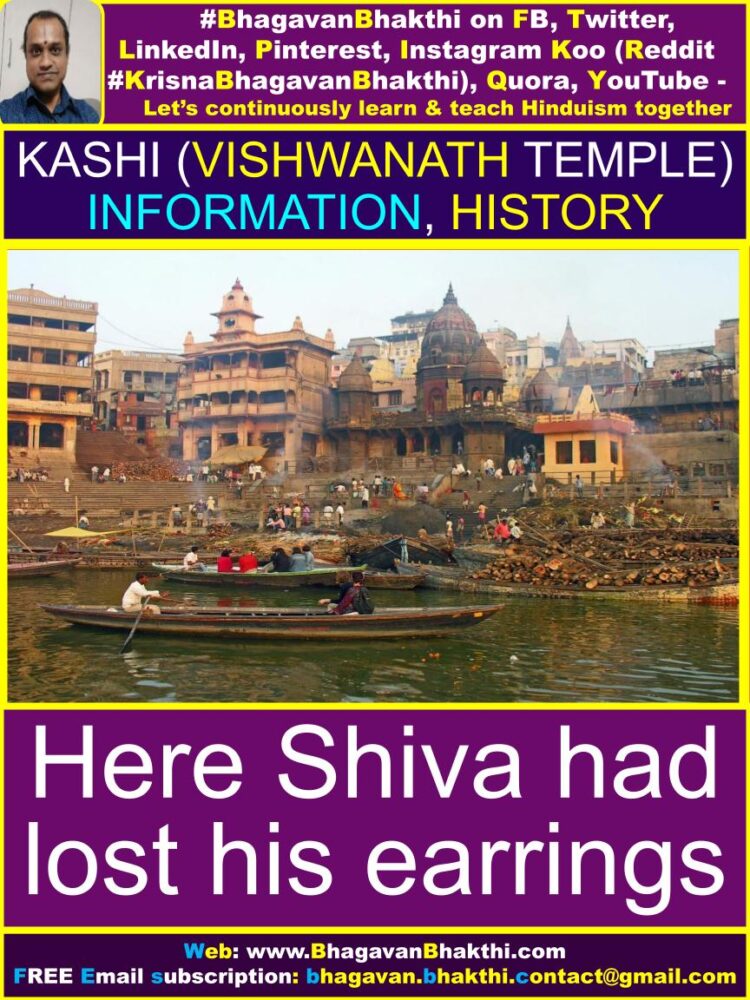
Bhagavan Lord Sri Vishnu made a request to Lord Shiva, that is, may this place fulfill the wishes of all those who seek moksha / salvation, since this place is blessed with your (Lord Shiva) eternal presence and thus it’s another name will be Kashi (along with the name Marnikarnika).
Lord Shiva assured Bhagavan Lord Sri Vishnu saying like this, “This pavitra / sacrosanct place is very much dear to me (Lord Shiva) and no event takes place here against my wish.
Even if a person living here happens to be a sinner, he has nothing to fear, because I protect him. One who lives far from Kashi, but remembers it (Kashi) with reverence becomes absolved of all his sins.”
Different Ghats at Kashi : Without making a reference to the Ghats of Kashi, story of Kashi will be definitely incomplete. Kashi is considered older than traditions. The divine grace of this city is highly unique in combination of physical, metaphysical and supernatural elements.
Similarly, ghats of Kashi are natural supplements to the concept of divinity. Kashi is a city that liberates soul from human body to ultimate Moksha. The much quoted Sanskrit sloka, ‘Kashyam maranam mukti’, that is, death in Kashi means direct liberation.
Kashi has nearly over 100 Ghats. Most of the Ghats are bathing Ghats, while others are used as cremation grounds. Many Ghats are associated with legends and great stories.
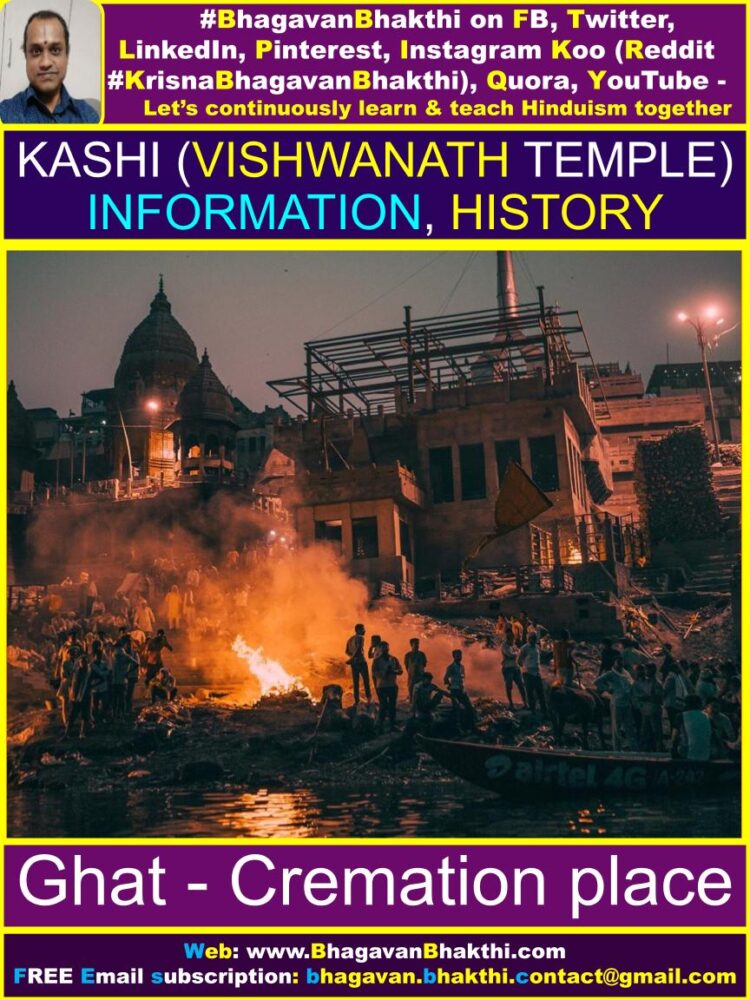
Among many, let us know few of them as given below:
Manikarnika Ghat : Manikarnika Ghat is popularly known as ‘Maha Smashanam’, that is, the great cremation ground. The name ‘Manikarnika’ derives its origin from the dropping rings of Lord Shiva during His transcendental tandav / divine dance here.
There also exists a sacred pond called as ‘Chakra Pushkarini Kunda’ and foot print of Bhagavan Lord Sri Vishnu, that is, known as ‘Karna Paduka’. Along the sacred route on the Ghat itself, there are the symbolic footprints of Bhagavan Lord Sri Vishnu (Karna Paduka).
Bhagavan Lord Sri Vishnu was said to have performed tapas / penance at this place for 7000 years.

Mainly there are two legends that are associated with Manikarnika Ghat: According to one, it is a place where Bhagavan Lord Sri Vishnu dug a pit with his Chakra and filled it with his sweat while performing the tapas / penance.
While Lord Shiva was watching this, at that time his (Lord Shiva’s) Manikarnika (earring) fell into that pit. According to the second legend, it is the place where the earrings of Goddess Sati Devi fell.
This Ghat’s area has ancient reputation as a cremation ground and it is said that Lord Shiva (the great destroyer) destroy the world here during deluge as per the wishes of Bhagavan Lord Sri Vishnu.

Harishchandra Ghat : Harishchandra Ghat, is named after the great King Harishchandra. He was the one who once worked here in this cremation ground for prevention of satya / truth. At the end, the Gods rewarded him and restored his lost throne and his dead son to him.
This is one of the two cremation Ghats, which is some times referred to as ‘Aadi Manikarnika’ the original cremation ground. But still there exists another ‘Aadi Manikarnika Teertha’.
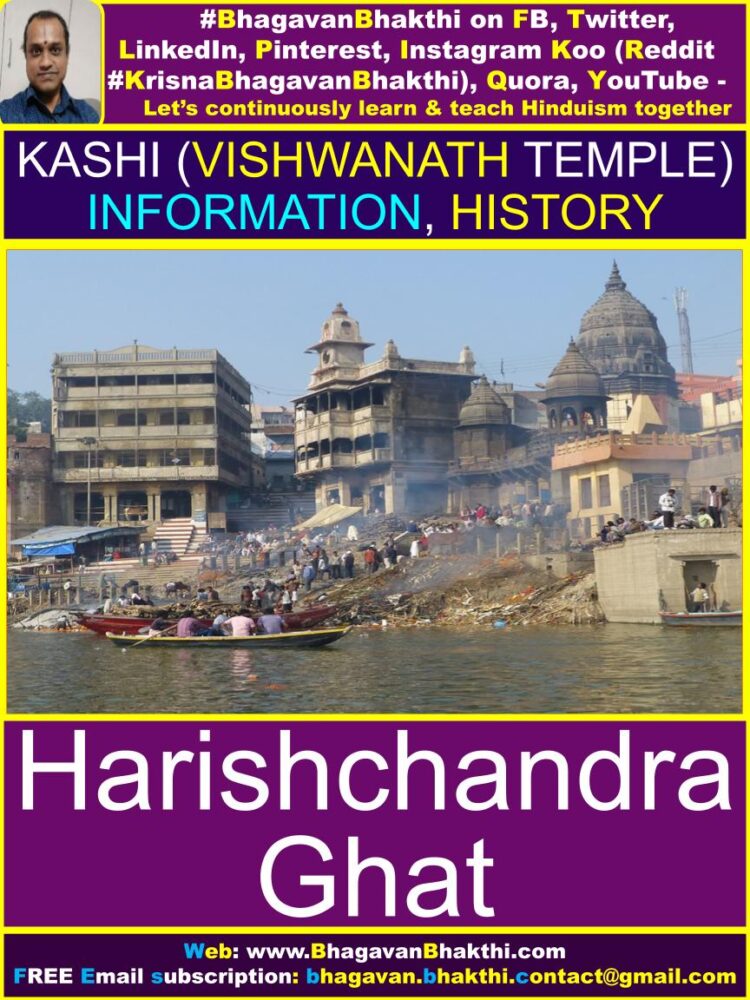
Hanuman Ghat : Saint Tulsidas has established a Hanuman Temple (Devalaya / Mandir) here which is famous as Hanuman Ghat. Ancient name of this Ghat was ‘Rameswaram Ghat’, which was established by Lord Rama himself. This place is mostly occupied by South Indian residents.

Dashaswamedh Ghat : Dashasvamedha ghat is located close to Viswanath Temple (Devalaya / Mandir). It is said that Lord Sri Brahma Deva created it to welcome Lord Shiva. It is also said that Lord Sri Brahma Deva sacrificed ten horses in a Yagna here and performed ‘Dasha Aswamedha Yagna’.
Thus the name ‘Dashaswamedha’. Here Dashaswamedha = Dasha + Ashwa + Medha = Ten + Horses Yagna (Sacrifice). This is the most busiest and ancient Ghat of all.
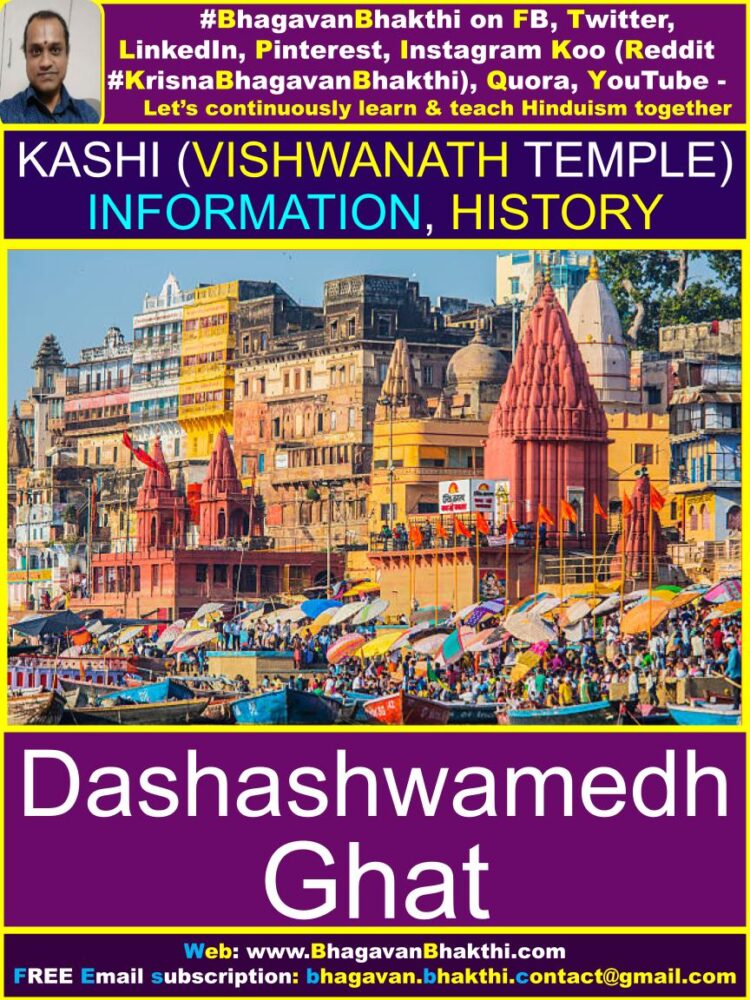
Prayaga (Prayag) Ghat : Prayaga (Prayag) Ghat (old Prayaga Teertha) together with shrine of Prayageshwara replicates the existence of Prayaga in Kashi. Prayaga is known as “Teertha Raja” (The king of Teerthas) lies at the confluence of the three rivers, that is, Ganga river, Yamuna river and the invisible Saraswati river.
It is commonly believed that doing Dharmic rituals and taking sacred bath here provide exactly the same religious merits as those at Prayaga (Prayagraj).
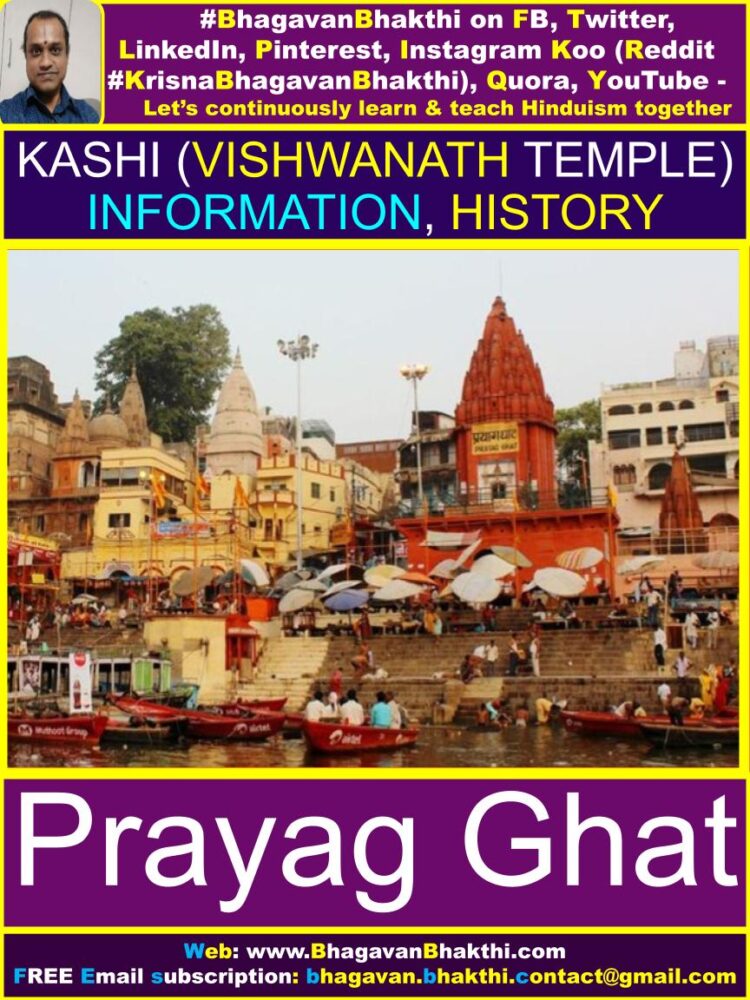
Some information about the present Kashi and the people of Kashi : Most residents of Kashi mainly speak ‘Kashika Bhojpuri’. This is very closely related to Hindi language.
American writer Mark Twain wrote: “Banaras is older than history, older than tradition, older even than legend, and looks twice as old as all of them put together.”
To know what the “Famous quotes about Hinduism, India by foreigners”, you can visit this link: Famous quotes about Hinduism, India by foreigners
People often refer to Kashi as “the city of temples”, “the holiest city of India”, “the religious capital of India”, “the city of lights”, “the city of learning”, “cultural capital of India” etc. Culture at Kashi is closely associated with the River Ganga and its religious importance.
The city Kashi has been a cultural and religious center India for several thousand of years. The Temple of Kashi Vishwanath has been visited by many great saints and several spiritual personalities.
Many prominent Indian philosophers, poets, writers, and musicians resided in this place and / or reside in Varanasi (Kashi) even today. The great Hindu Dharmic medicine ‘Ayurveda’ is said to have originated from Kashi.
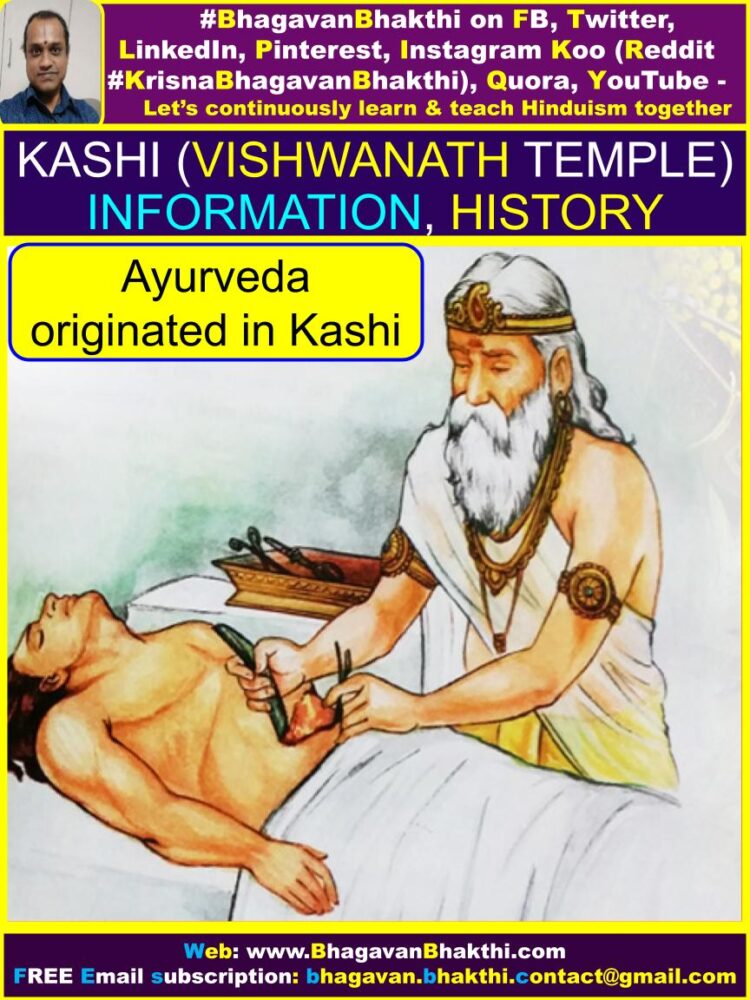
Being one of the four pilgrimage sites said to have been designated by Gautama Buddha himself, Kashi is one of the holiest places for Buddhists also. It is believed to be the birthplace of Parsvanath, the twenty-third Teerthankara of Jains. Kashi is also a pilgrimage site for Jains.
Deeply engrossed in Hindus Dharmic mind, Kashi Viswanath Temple (Devalaya / Mandir) has been a living example of our timeless cultural traditions and higher spiritual values. Kashi attracts visitors not only from India, but also from abroad.
More than one million pilgrims visit the city each year. Both Vaishnavism and Shaivism have always co-existed in Varanasi peacefully since unknown time. Sanatana Dharmi Hindus believe that bathing in Ganga remits our sins and that dying in Kashi ensures release of a person’s soul from the cycle of its trans-migrations.
“न गायत्रय पर मंत्र, न मातृ पर दैवतं, न काश्य पर परम् तीर्थं, न एकादस्य समं व्रथम्” | “ನ ಗಾಯತ್ರಯ ಪರ ಮಂತ್ರ, ನ ಮಾತೃ ಪರ ದೈವತಮ್, ನ ಕಾಶ್ಯ ಪರಮ್ ತೀರ್ಥಂ, ನ ಏಕಾದಸ್ಯ ಸಮಂ ವ್ರತಮ್” | “na gāyatraya para mantra, na mātr̥ para daivatam, na kāśya param tīrthaṁ, na ēkādasya samaṁ vratam”
Meaning of this sloka is as given below: There is no ‘mantra’ that is superior to ‘Gayatri mantra’, there is no daivam (deity) superior to Mother, there is no celestial and sacred teertham (pilgrimage place) better than Kashi, and there is no vratam (vow) that is more sacred than Ekadashi vratam (vow).
To be in Kashi a sacrosanct place is an experience in itself.

Temples at Kashi and it’s significances is as given here: Kashi, also called as Varanasi is a city of various devalayas / temples / mandirs. It is said that there are more than 2000 devalayas / mandirs / temples in Kashi alone.
Every nook and corner in Kashi has a devalaya / temple / mandir. Though many small temples form the basis of day today’s local prayers and other ceremonies, there are many large and famous devalayas / temples / mandirs erected at different times through out the history of Kashi.
Kashi Vishwanath Temple (Devalaya / Mandir) : Kashi Vishwanath Temple (Devalayam / Mandir) is also called as Golden Temple is located on the outskirts of Ganga river. This devalaya / temple / mandir makes Kashi a place of great dharmic importance to Hindus, as the great Jyotirlinga of Lord Shiva is enshrined here.
Usually this devalaya / temple / mandir opens daily at 2.30 a.m. and closes at 11 p.m. This devalaya / temple / mandir was once destroyed by the Muslim Sultan Aurangzeb, who had built a mosque over it. It was later resurrected at a location near the mosque.
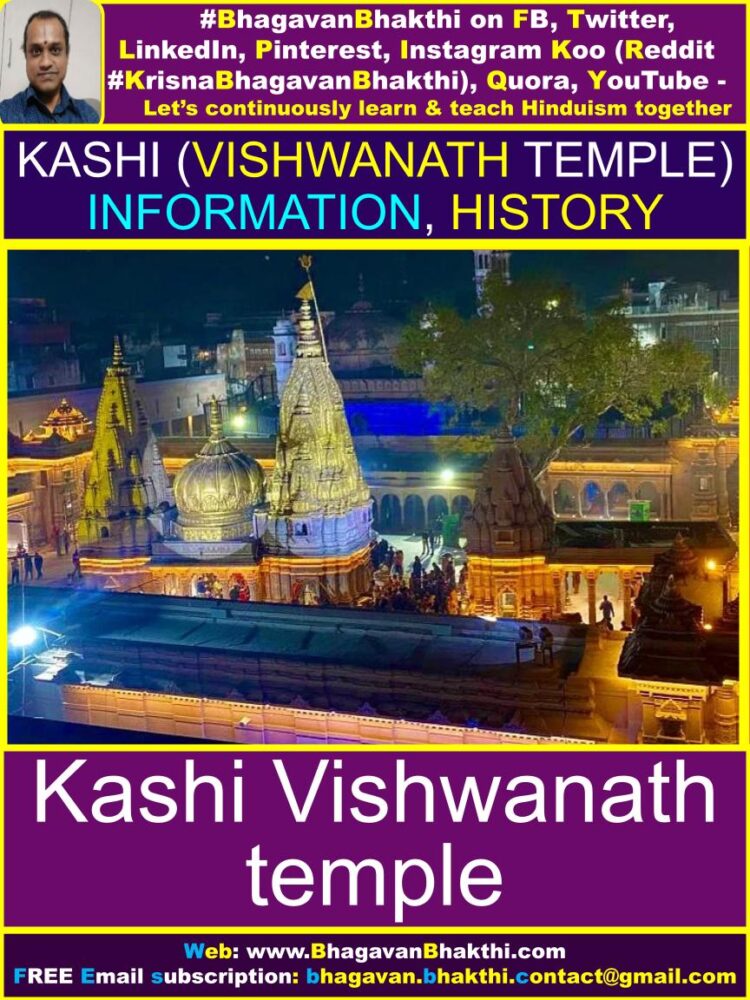
Annapurna Temple (Devalaya / Mandir) : Goddess Annapurna Devi is an avatar of Goddess Sri Parvati Devi. She is the Hindu Goddess of nourishment.
Here ‘anna’ means food & grains and ‘purna’ means full, that is, someone who is complete and perfect and also someone who fetches everyone with full stomach. As Goddess Annapurna Devi is the personification of food and source of all foods, Goddess Annapurna is called the Supreme Goddess of the city of Kashi.
It is said that Goddess Parvati Devi took the form of Annapurna and appeared with a golden pot full of cooked rice and a golden ladle. Lord Viswanath (Lord Shiva) himself asked Bhiksha (alms) from her.
To know the story of this, you can visit this link: Real story of Brahma Deva’s fifth face
Even today, nobody sleeps with hunger in Kashi. The devalaya / temple / mandir of Goddess Annapurna Devi is located near the temple of Lord Viswanath.

Durga Devi Temple (Devalaya / Mandir) : Durya Devi devalaya / temple / mandir also nicknamed as “Monkey temple”. This temple got the name ‘Monkey temple’ because of the presence of large number of monkeys in and around the devalaya / temple / mandir.
According to legends, idol of Goddess Durga Devi is said to be self manifested here. Apart from regular visits, thousands of Hindu devotees visit this temple during Navaratri and other auspicious occasions.

Vishalakshi Temple (Devalaya / Mandir) : First let us know the correct meaning of this word “Vishalakshi”. Here Vishalakshi = Vishala + akshi = very wide + eyes. This means, someone who has very wide eyes.
The great city of Kashi is considered to be one of the ‘Shakti Pitas’ of India. The earrings of Goddess Sati Devi (consort of Lord Shiva) fell at this very place in Kashi and this devalaya / temple / mandir is one among the 18 ‘Shakti Pitas’.
It is one of the famous trinity of temples (that is one temple among the other two temples). The other two devalayas / temples / mandirs are ‘Kanchi Kamakshi’ and ‘Madurai Meenakshi’. This Vishalakshi devalaya / temple / mandir is situated in one of the narrow lanes around Viswanath Temple.

Kaala Bhairava (Kaal Bhairav) Temple (Devalaya / Mandir) : Kaala Bhairava devalaya / temple / mandir is an ancient temple of Kashi and it is located near Head Post Office at Kashi. Kaala Bhairava is believed as “Kotwal of Varanasi”.
Without Kaala Bhairava’s permission no one can stay in Kashi. Kaala Bhairava is the ‘Kshetra paalaka’ (protector of the place) of Kashi. Every one should visit this devalaya / temple / mandir in their Kashi Yatra. Kaala Bhairava will take all the sins of devotees living in or visiting Kashi.
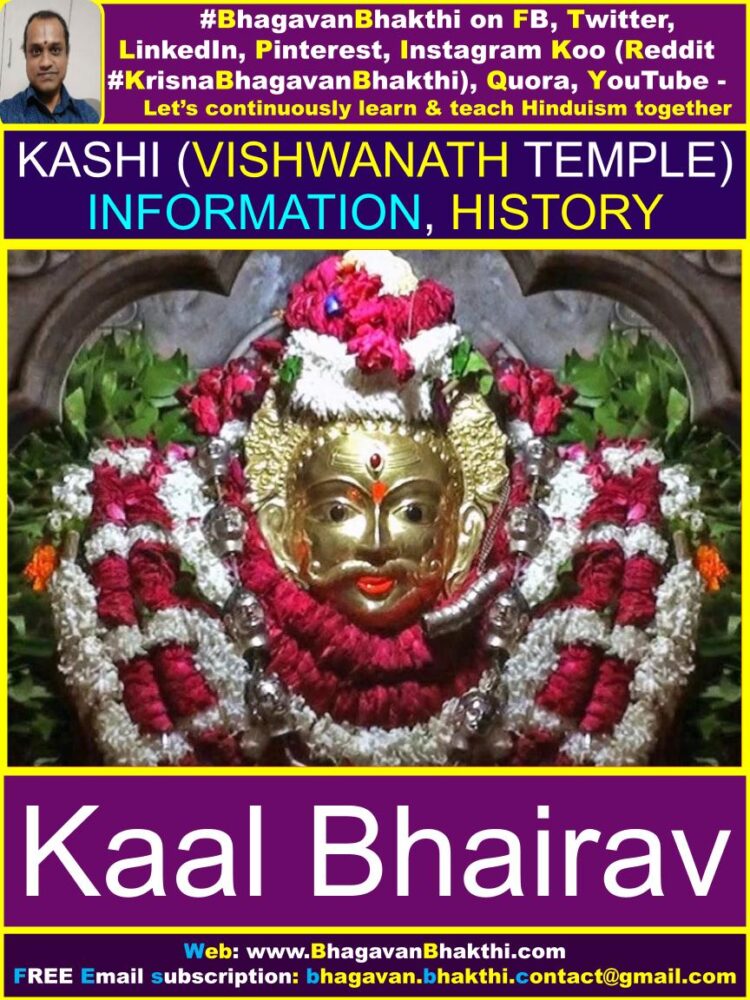
Bindu Madhava (Madhav) Temple (Devalaya / Mandir) : Among the oldest temples in Kashi, Bindu Madhava (Madhav) devalaya / temple / mandir near ‘Panchaganga Ghat’ is one of the prominent devalayas / temples / mandir.
This devalaya / temple / mandir is also one of trinity (that is one temple among the other two temples). The other two devalayas are ‘Veni Madhava (Madhav)’ at Sangam in Prayagraj and ‘Setu Madhava (Madhav)’ at Rameswaram.

Sankat Mochan Temple (Devalaya / Mandir) : Sankata Mochana Temple (Devalaya / Mandir) is dedicated to Lord Hanuman and is highly popular with the local citizens.
Besides the Assi river stream, on the way to Durga devalaya / temple / mandir and to Banaras Hindu Temple (Devalaya / Mandir), this well known temple of Lord Hanuman is situated. Lord Hanuman is also known as “Sankata mochana”, that is, the god who protects from all types of troubles.
This devalaya / temple / mandir is founded by Saint Tulsidas. This temple is also known as “Monkey” temple, as lot of monkeys’ are there in and around the temple premises.
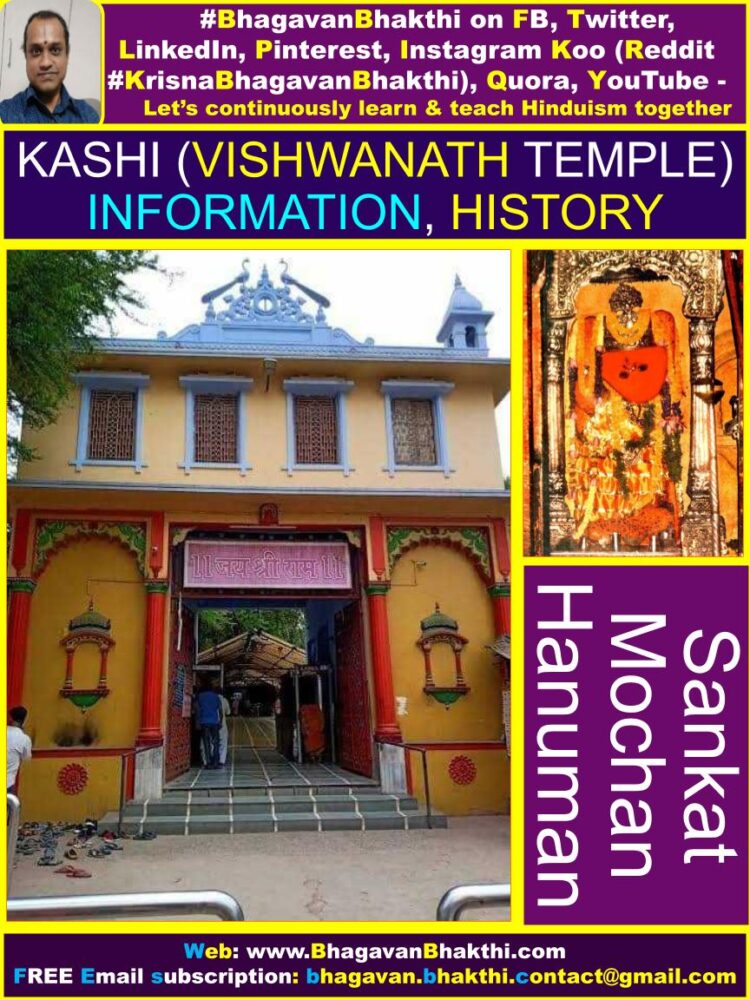
Chozi (Kaudi) Maata Temple (Devalaya / Mandir) (Cowrie Maata) : Without a visit to the Chozi Maata devalaya / temple / mandir, if someone visits Kashi is considered incomplete. Chozi Maata devalaya / temple / mandir is known by various names such as Chozi or Cowrie Maata or Gouri Maata devalaya / temple / mandir.
The name owes its origin to cowries or shells which are thrown at the goddess as offering. This Goddess here is considered to be a sister of Lord Kashi Viswanatha.
According to a story, she had her temple within the ancient temple complex. On one occasion Lord Shiva banished her and sent her out of the temple for which she repented. But as a mercy Lord Shiva decreed that all those who visit Kashi should also visit her.
A trip to Kashi will be ineffective, without visiting her temple. Hence, it has become a practice to visit Chozi Maata temple after visiting all the temples in Kashi. One should buy cowries outside the temple, must throw a few at the Goddess and ask her to bless them bestowing the fruits of their Kashi Yatra pilgrimage.
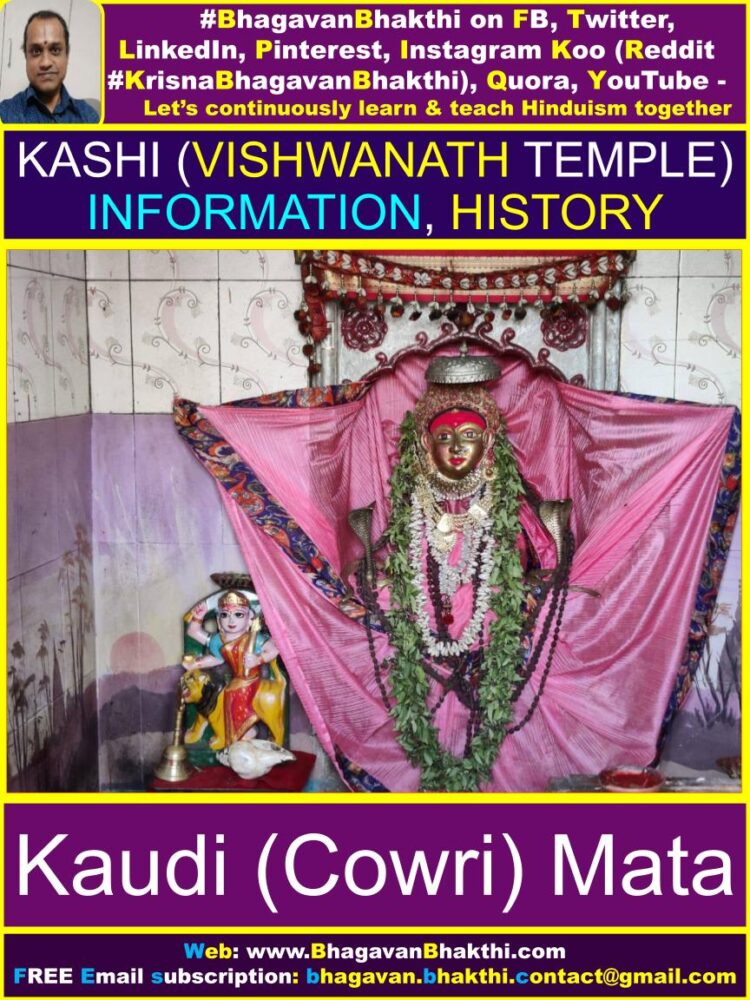
New Viswanath Temple (Devalaya / Mandir) : This devalaya / temple / mandir is also called as Birla Mandir. This is built as a replica of the old Kashi Viswanath devalaya / temple / mandir. This devalaya / temple / mandir is a part of the Banaras Hindu University.
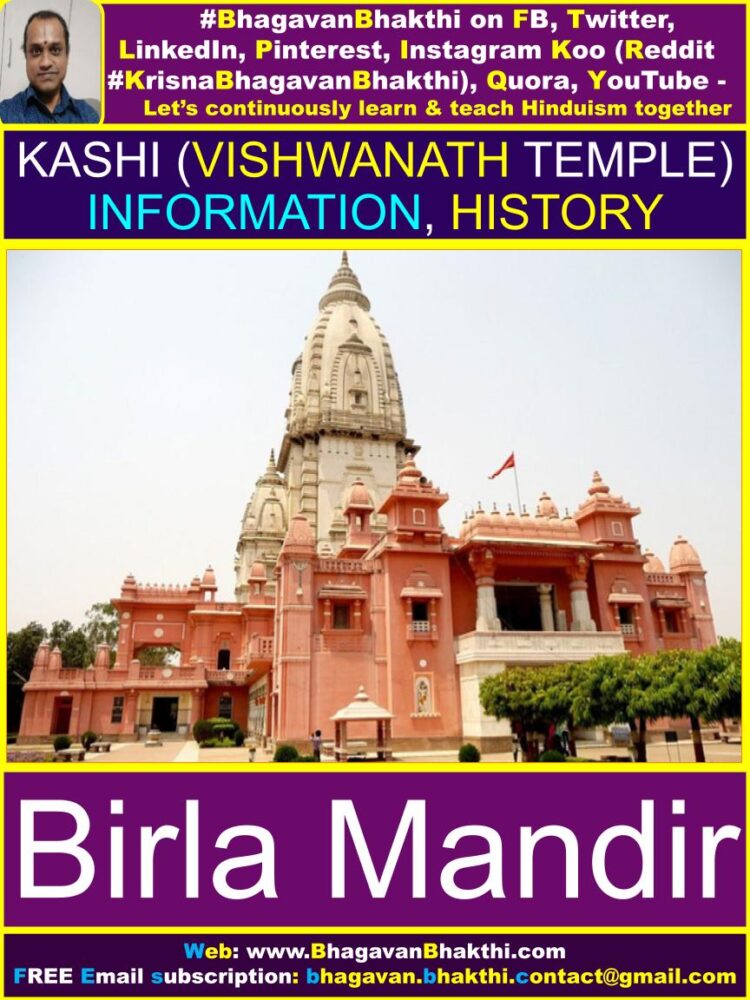
Dhundiraj Vinayak (Ganapati) Temple (Devalaya / Mandir) : As a sampradaya / traditionally speaking, the temple circuit at Kashi begins with a visit to ‘Dhundi Ganapati Temple (Devalaya / Mandir)’. This devalaya / temple / mandir is located on the way to the Viswanath temple.
This is a very small temple, looking like one on the roadside, but one of the important temples to be visited. While entering Viswanath temple, one should pay respects to Lord Ganesha while standing in the queue.
This devalaya / temple / mandir is near this place where, security check is made. This Ganesha has three eyes.

Saranatha (Sarnath) : Saranatha is renowned for ancient remains of Buddhist stupas, monasteries and temples is situated at a distance of 6 km to the north of Kashi city. Saranatha is one of the four most important Buddhist pilgrimage centers of India.
Bhagavan (Lord) Buddha, after attaining enlightenment at Bodh Gaya came to Saranatha and delivered his first sermon to five disciples. Saranatha is also holy and sacred to the Jains.
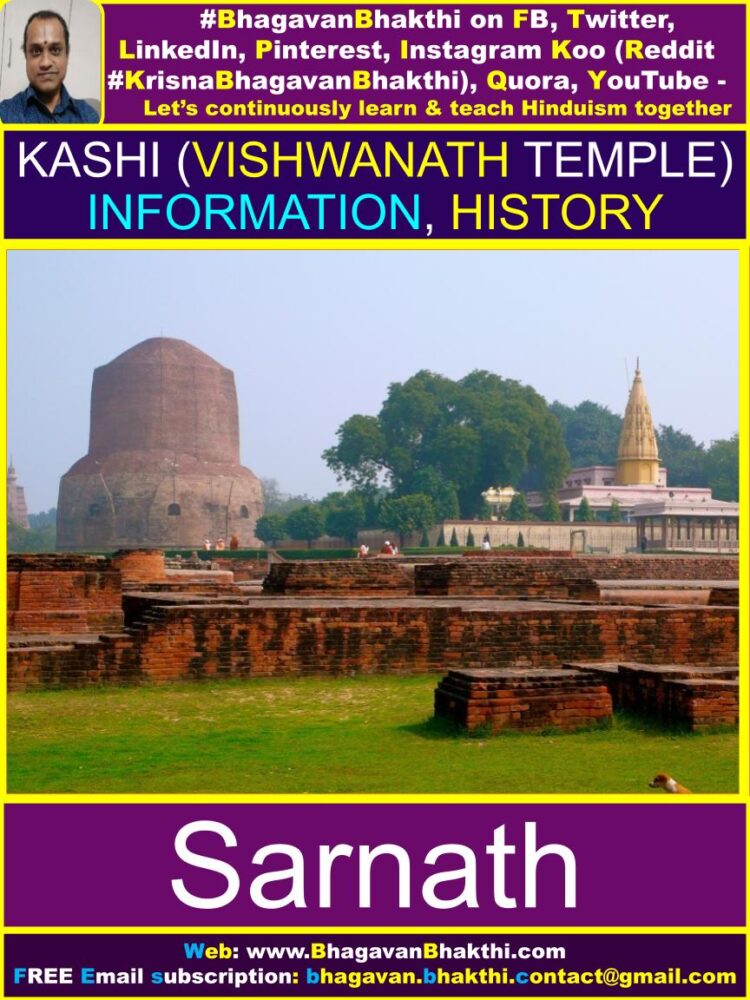
Vyasa Kashi : Once upon a time, Bhagavan (Lord) and Sage Vedavyasa Ji (He is an avatar of Bhagavan Lord Sri Vishnu) came to Kashi with his disciples and went for Bhiksha (holy offering of food for sadhus). But at that time no one gave them the Bhiksha (alms).
They all slept with empty stomach in the city of Annapurna Devi. This same condition continued for seven days. Bhagavan Lord Sri Vedavyasa Ji got angry and was prepared to curse the place Kashi. But at that time, Goddess Annapurna then appeared before him and gave all of them the Bhiksha.
Lord Vishwanath also appeared there, but banned Bhagavan Lord Sri Vedavyasa from coming to Kashi, as he was prepared to curse the place Kashi. But on praying, Lord Shiva told him that he can live on the opposite bank of Ganga river at Kashi and hence that place came to be known as Vyasa Kashi (Kasi – In Ramnagar, Kashi).
It is located in the mid way between Kashi and Mughalsarai about 6 km from Kashi (Varanasi).
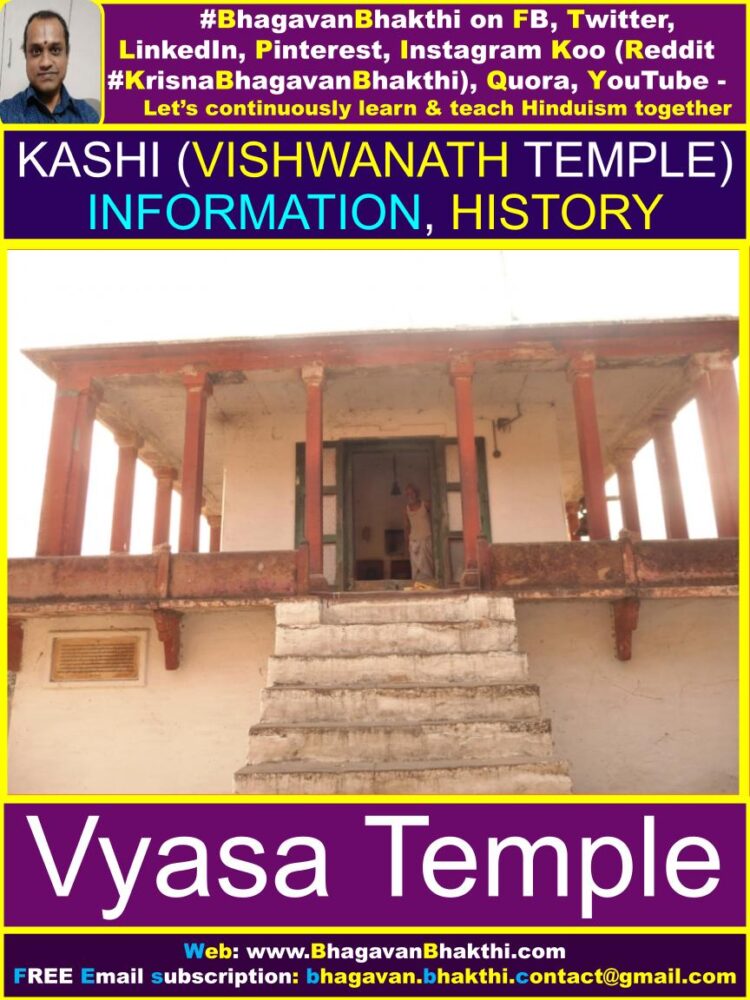
Tulsi Manas Mandir : This mandir / temple is dedicated to Bhagavan Lord Sri Rama. It is located at the place where, Tulsidas lived and wrote the epic “Sri Ramcharitmanas”. Verses from Tulsidas’s epic are inscribed on the walls. This mandir / temple is just nearby to Durga Temple (Devalaya / Mandir).
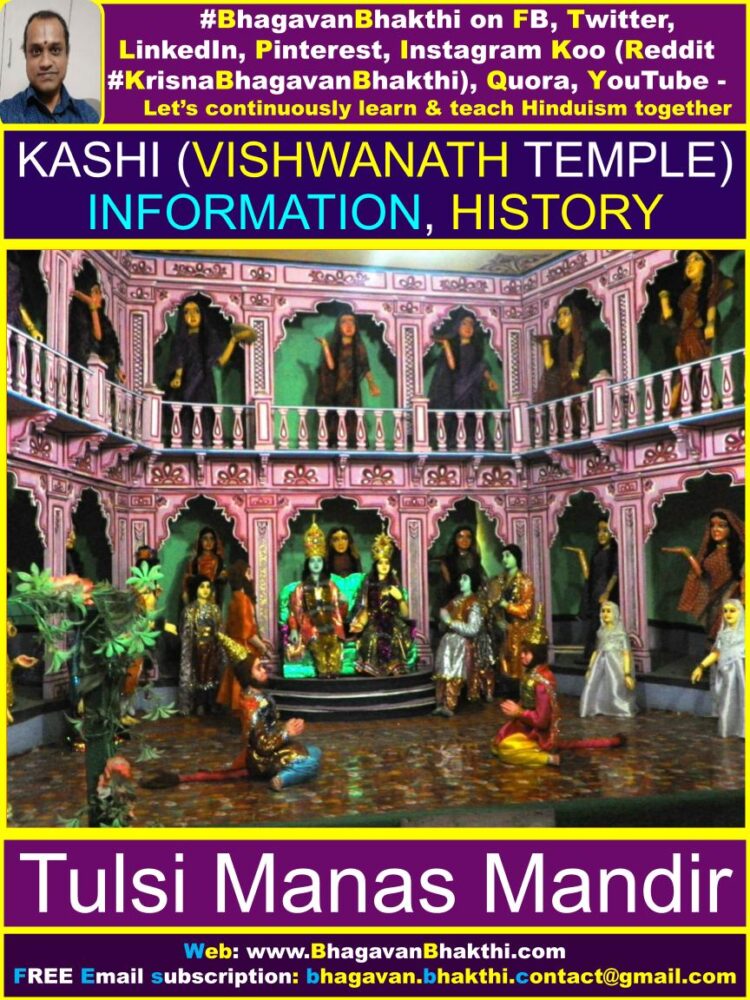
More information will be added to this on regular basis. Please visit this post again and other posts of this website (blog) to get the updated information
To watch videos on #Hinduism #Sanskrit language, SUBSCRIBE to my YouTube channel from this below link:
#BhagavanBhakthi YouTube channel
To know full information about “Pilgrimage places in India“, you can visit this link:
To know full story of “How Lord Srinivasa (Balaji) (Venkateswara) got married with Padmavati Devi“, you can visit this link:
Sri Srinivasa Kalyanam (marriage) full story
To know “Lord Krishna unknown facts and information“, you can visit this link to gather more information:
Lord Krishna unknown facts and information
Dear friends, if you need any clarifications about this post, kindly let me know, I will definitely try to answer all of them.
Also your one LIKE, one COMMENT, One Share, one SUBSCRIPTION is highly important.
This will help to know the quality of this content and also it will be helpful to know if any improvements is required for the content.
If you feel this content is useful to you and has helped you to improve your knowledge, kindly share this with your well-wishers.
Because “SHARING MEANS CARING”.
For receive FREE EMAIL SUBSCRIPTION about #BhagavanBhakthi, you can send an email to [email protected] from your email ID.
NAMASTE!
SRIGURUBHYO NAMAHA
OM NAMO NARAYANAYA
Sri Krishnaarpanamastu
Share in Social Media